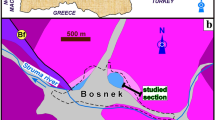Abstract
In the Western layered syenite stock of the Kûngnât complex, close to the intrusion wall, there are two groups of regularly spaced, horizontally aligned, stacks of infilled troughs. These features resemble, to some extent, the trough layering within the UZa trough zone of the gabbroic Skaergaard1 intrusion. Such features have never before been described in syenitic rocks. The lower group comprises six stacks of infilled troughs; the upper group comprises seven. The two groups are vertically separated by about 10 m of sparsely layered syenite. The infilled troughs in the upper group are stacked vertically; those in the lower group gradually shift laterally and appear to converge over an antiformal structure. It is not possible to measure the plunge of the troughs due to outcrop geometry. Troughs are up to about 80 cm deep. The material filling the troughs is more melanocratic than the syenite that surrounds them. Individual troughs exhibit normal grading. The syenite within the troughs contains large amphibole and biotite oikocrysts. Faintly layered syenite occurs laterally between stacks. Minerals in the host syenite are more ferroan than those in the troughs, this is thought to represent re-equilibration with residual melt. Feldspar textures, irregular pyroxene and apatite zoning, and the presence of irregular shaped amphibole patches within pyroxene grains all imply alteration by a pervasive deuteric fluid in both troughs and host syenite. We suggest the following hypothesis for the formation of the troughs. A mafic crystal sheath which grows on the walls of the magma chamber becomes detached and flows downwards. The descending slurry forms a series of regularly spaced streams which erode trough shaped channels into the crystal pile at the base of the chamber. Uneroded crystal material separates the channels. Crystals are deposited from these streams. Successive streams flow over each other to generate stacks of troughs.
Similar content being viewed by others
Author information
Authors and Affiliations
Additional information
Received: 20 February 1996 / Accepted: 16 September 1996
Rights and permissions
About this article
Cite this article
Hodson, M., Finch, A. Trough structures in the Western syenite of Kûngnât, S Greenland: mineralogy and mechanism of formation. Contrib Mineral Petrol 127, 46–56 (1997). https://doi.org/10.1007/s004100050264
Issue Date:
DOI: https://doi.org/10.1007/s004100050264




